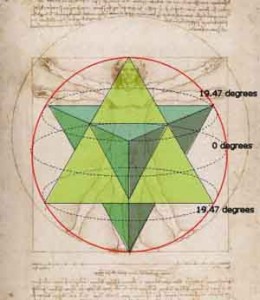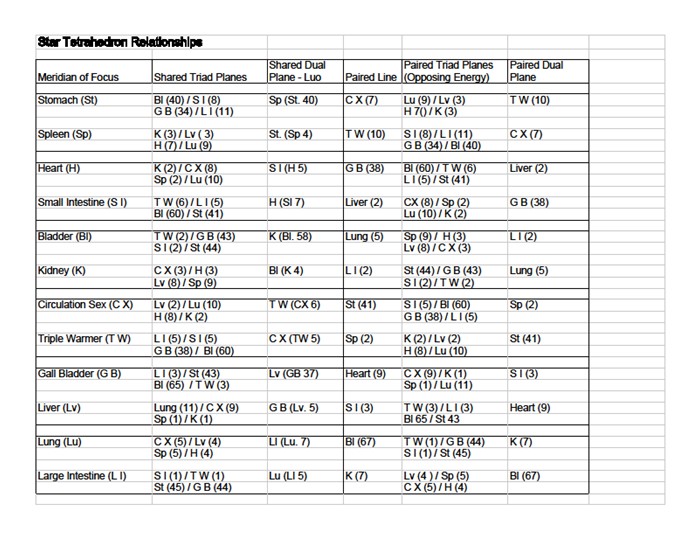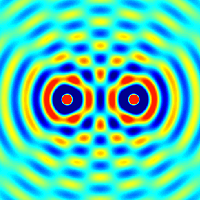
Seers, in describing how they see the clustering of energetic filaments that assemble into living things, repeatedly turned to graphical models. A model that independently emerged in many different ancient cultures is The Flower of Life. One example of its use appears in “The Star of David”. The Flower of Life is a two-dimensional representation of the energetic relationships that Seers see, which is quite likely concurrently present in four, if not five, or even more dimensions. The most fundamental three-dimensional representation of the Flower of Life is the Star Tetrahedron. One of the greatest minds of the first millennium, Leonardo Da Vinci, invested a good deal of his perceptual capital in exploring both the Flower of Life and the Star Tetrahedron. DA VINCI ATOM MODEL
An interesting attribute of this three-dimensional model of clustering of the energetic attributes of living things is that it has 12 edges. Using the 24-hour energy flow represented in the 2-dimensional “Wheel” from Traditional Chinese Medicine (TCM), the flow of energy through the 12 meridians can be mapped onto the Star. From this author’s experimentation, it appears that there is only one way in which the meridians can be mapped that encompasses the rules of energetic flow as depicted on the Wheel, which is the most ancient Chinese model for mapping energetic flow through the human body. When organized in this way, the star affords a three-dimensional perspective of that which is represented two-dimensionally on the wheel. This three-dimensional model, while including all of the relationships present in the wheel, offers many more relationships that when viewed from this perspective, have an equal potential for energy balancing. It additionally affords differing perspectives for viewing the energetic dynamics of the 12 meridians from TCM.
This model is perhaps an order of magnitude more complex than the two-dimensional model presented in the Chinese “Wheel”. To simplify using the model, I have organized balancing options to a specific meridian of interest. This meridian is listed in the first column of the attached table, while the rows to the right of this meridian contain meridians in specific relationships. These relationships are based on how the meridians are dimensionally related to the meridian of interest. These dimensional relationships as organized in the table in the link here are discussed in the next section.
PDF TABLE OF MERIDIAN RELATIONSHIPS
Introduction to the Model:
While the Chinese model of energy balancing pays attention to the flow of energy through the meridians, the broader body of energy medicine pays equal or greater attention to the vibrational qualities of energy, its resonance, or dissonance to other energy segments. When viewed two-dimensionally this quality of synchronization of resonance is not apparent, however in a three-dimensional model, vibrational relationships become much more easily distinguished. When viewed in this way, a priority of balancing options emerges. This priority assumes that balancing the resonance of energetic filaments that share a dimension will have a more direct effect than balancing the resonance of energetic filaments that do not. This establishes the order of the columns of meridians. The Acupressure Holding Points (AHP) listed are the points to bring the meridian into resonance with the element of the meridian in the first column.
Details of the Model:
Organizing the Meridians on the Star:
The tetrahedron is the most primitive of the Platonic solids, meaning it is the simplest known geometric form in three dimensions. The Star Tetrahedron is a combination of two tetrahedrons with opposed orientation. In a spiritual context, these two solids are usually taken to represent the male and female attributes of energy clusters. The bulk of the male, or yang tetrahedron is above the horizontal midline of the star, with the bulk of the female, or yin tetrahedron below. This principle, with the added assumption that the upper body meridians should be placed on the star above the placement of the lower body meridians, established the meridian placement guidelines. Following these two guidelines, and placing meridians on the star in the 24-hour cycle as represented by the Wheel, it seems that there is only one solution for the placement of each meridian. This is a key point, as more than one solution would deeply challenge the utility of the model. Once labeled, a variety of energy relationships can be observed in the star that is obscured in the wheel.
SHARED TRIAD PLANES
These are clusters of three meridians that include the meridian of interest. There are two of these clusters for each meridian. Because these meridians share either Yin or Yang energy, they can be synchronized to the meridian of interest using command points. If you have an energetic imbalance with three meridians, one in the first column and two in one of the next two rows, this would be a priority balancing option.
SHARED DUAL PLANES
These are clusters of two meridians that combine to make the elements. Each plane contains a Yang and Yin meridian, and they are balanced using the Luo points. The Star Tetrahedron has 6 faces (cube) and each element encompasses one of these faces. An imbalance in any of these faces is a priority balancing option.
PAIRED LINE
These are meridians which run parallel to each other. On the wheel, these meridians are represented in the midnight, mid-day cycle. These meridians are balanced using the command points for the element of the meridian of interest. An imbalance based on this relationship would have a slightly lower priority although these meridians share a dimension, they are physically separated and will be entrained by the quality of waves known as Sympathetic Resonance.
PAIRED TRIAD PLANES
These are clusters of three meridians that have opposing energy to the meridian of interest. Each row has a plane that runs parallel to the triad cluster of the meridian of interest. These meridians are also balanced to the meridian of interest using the command points of the element of that meridian.
PAIRED DUAL PLANES
These are meridians of another element that share a plane with the element plane of the meridian of interest. From the Star model, this meridian appears to have the weakest relationship with the meridian of interest as its orientation is shifted 90 degrees. These are balanced using Command Points.
CENTRAL AND GOVERNING MERIDIANS
These meridians run vertically through the middle of this model
OTHER CHARACTERISTICS OF THE MODEL:
24 Hour Cycle (Beaver Dam):
The 24-hour cycle of meridian flow, when examined from the perspective of a static, three-dimensional structure, has some interesting characteristics. As living things circle with the rotation of the planet every 24 hours, at any given time a meridian or pair of meridians faces the sun. This facet of maximum exposure can be considered the time of day of that meridian(s). As the static structure continues to turn with the rotation of the planet, each meridian in the 24-hour cycle has a period of maximum exposure. It would not be so much that meridian energy flows from one meridian to the next, but that each meridian (or meridian pair) would be maximally stimulated and dominate the energetic dynamics at some point in the 24-hour cycle.
This concept suggests a few interesting points. It suggests that the stars of all living things are aligned in the same orientation independently of how those living things move about. It also suggests that the stars of all living things maintain a similar alignment, to their longitude on the planet. When we travel, our star must realign with the local orientation, which is what occurs in the Time of Day Balance.
OVER / UNDER ENERGY
The Star Tetrahedron model for energy balancing affords a slightly different perspective on the Chinese model of balancing excess or deficient Chi. Energetic vibrations of differing frequencies and timing will combine either constructively or destructively. This is commonly referred to as Interference. Using this quality of interacting waveforms, an understanding of which was not available to the ancient Chinese Seers who formulated the acupuncture model, we can view energy balancing as modifying the timing (phase), frequency (pitch), and amplitude (volume) of waveforms (meridians). This is true for clusters of meridians that are dimensionally connected, and those that are dimensionally parallel, through the quality of vibrational synchronization. From this perspective, we do not so much move Chi from regions of excess to where it is deficient, as bring waves into a more harmonious and supportive organization.
EXAMPLE:
A client presents with an issue that is placed “in circuit” using Circuit Retaining Mode. The priority meridian is identified and stacked with the issue. The client can hold this stack. Opening the table we look across the rows for the priority meridian. For example, if the priority meridian is Spleen, we see K / Lv, and H / Lu. We check the alarm points for these meridians, and if we find an imbalance, we hold the AHP for the meridian pair. These points will balance the elemental resonance for those two planes. Continuing across the row we continue to hold points for any alarm point that shows. Consequently, we have checked the alarm points in the order: (H/Lu; K/Lv), St, TW, (SI/LI; GB/Bl), CX.
END NOTE:
At best, this model is a theorem. I continue to experiment with it by using the table as a balancing guideline and often find interesting relationships and clues as to where to proceed in a balance. The relationships correlate quite well with my experience in energy balancing and I rarely find that I have “dead-ended” in using it. There are many assumptions in the model, the biggest one being the points for balancing. I would be very interested in any comments and suggestions as to how to further develop the model, particularly information on other acupoints that relate to the meridian clusters described in the table.
A classmate (Melodi Simay Acar) and I constructed a model of this concept as a class project and presented a video on the concept:




